This walking water experiment is the perfect science activity to do with kids on a rainy day, preschoolers included. All you need is 7 clear cups or containers, red, yellow, and blue food coloring, water, and paper towels. This is one of my all-time favorite science lessons because while it teaches kiddos about capillary action, it also teaches them about color theory… And honestly, looks like a magic trick!
I’ve used this with many grades and it’s been a hit every single time. Below are the steps to create this experiment at home. And, if you want, you can skip right to the instructions.
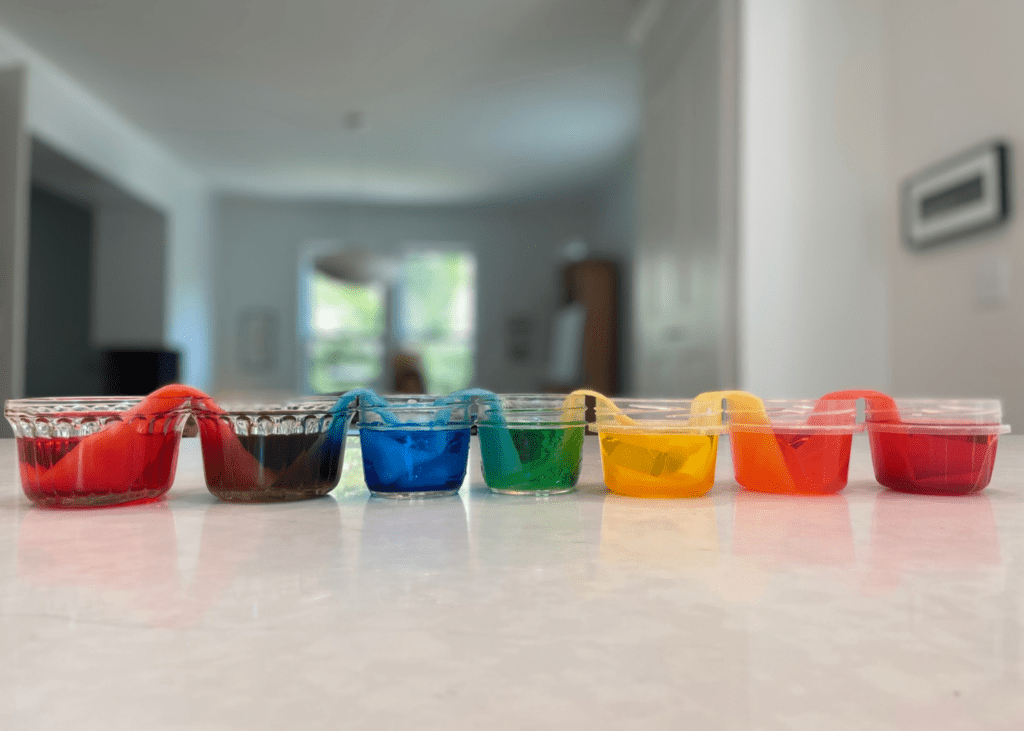
What is the walking water experiment?
This is an excellent activity for young scientists – Especially those who love color! Learn why we think science for kids is so important in this post.
This walking water experiment is a super quick and easy science experiment that teaches children about capillary action and a little bit about color theory, too! Every time I’ve done this with a class (or with a small group of children) they excitedly say “Ms. C!! It’s like magic!!” And, honestly, I totally agree!
What’s happening in this rainbow walking water experiment is that there is a strong adhesive force between the paper towel and the water that overpowers the cohesive force in the water molecules themselves (and in the food dye molecules you add to the water). Basically, the water molecules grab onto the cellulose fibers of the paper towel strip (adhesion). The tiny gaps between the paper towel fibers act like capillary tubes that pull water upward. Since there is a cohesive force between the water molecules, the water molecules stick together while traveling up these tiny little paper towel fibers.
At first, it may appear like the water is trying to defy gravity by traveling up the paper towel as the attractive forces make the water appear to magically move. But, once the water reaches a certain point in the paper towel, gravity will work its own magic and the water will begin to travel back downwards – Creating a rainbow of colors in your row of glasses!
What you are seeing is the process called “capillary action.” You’re also watching surface tension in action, because that’s what keeps the water on the paper towel.
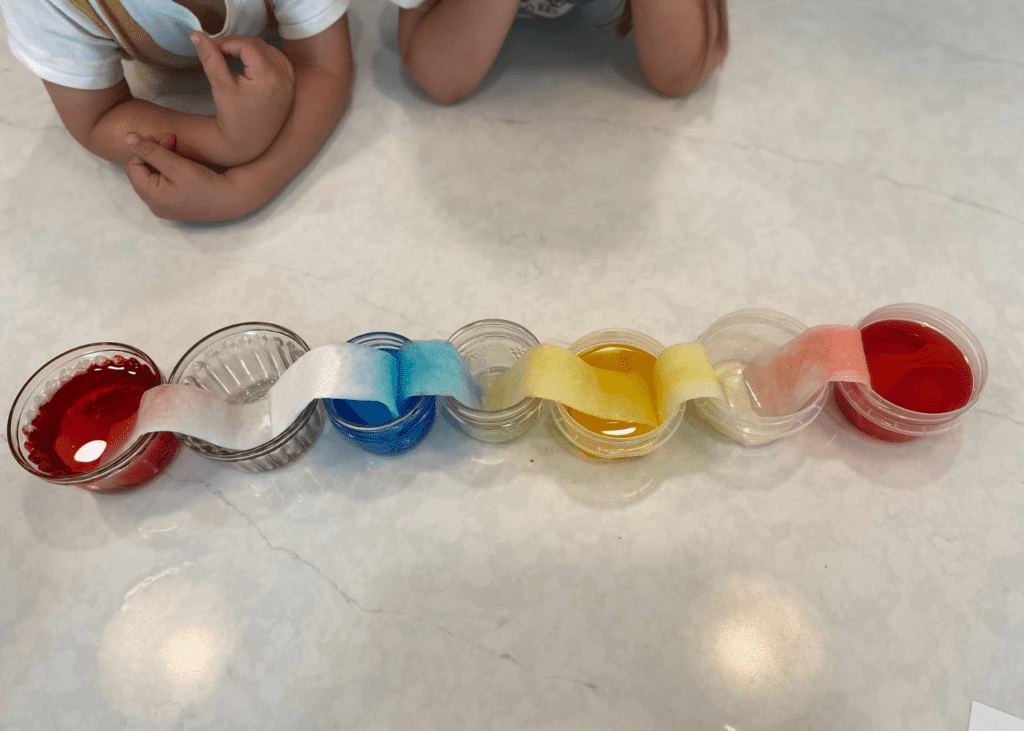
Download a scientific method worksheet before starting
This is totally optional, but you may want to head over to my TpT store and download the Scientific Method worksheet for free. This way, you can emphasize key learning moments while introducing your preschooler to the scientific method. By practicing this, they will become confident in their ability to hypothesize, test, and evaluate experiments!
Plus, if you write down the step-by-step instructions and tuck this away in a folder for later, they can re-create the same activity another time.
How to create the walking water science experiment
This simple project uses just a few household materials to create a beautiful rainbow effect. Plus, it’s a great way to teach your little one about the properties of color mixing. Follow the steps below to get started.
Here is everything you will need to make your own volcano experiment at home:
Materials:
- 7 clear/short glasses
- 6 strips of rolled paper towel (or folded like ours in the picture above)
- I’ve found that more absorbent paper towels work best, but the cheap ones work fine too!
- Food coloring in red, yellow and blue
- Water
That’s it! Make sure to carefully follow the directions below and you’ll be able to watch the walking rainbow experiment in action!
Instructions:
It’s important to be careful about which cups you pour water and dye into! You do not put water into all the jars.
- Place 7 jars in a straight line
- Fill jars 1, 3, 5 and 7 with the same amount of water in each
- Fill them right up so you can make water walk from one jar to another!
- Put 5 drops of red food coloring in jars 1 and 7
- Put 5 drops of blue food coloring in jar 3
- Put 5 drops of yellow food coloring in jar 5
- Carefully place a strip of paper towel between each jar
- Dip it into the water of the jar with the water and make sure it’s just long enough to go into the adjacent jar. Trim off any excess paper towel!
- Wait a few minutes and watch the walking water rainbow begin to form!
- If you look close enough, you can actually watch the forces between the water, color, and paper towel at play. Fiber by fiber, you can watch the paper towel absorb the color before dripping it into the cup.
- …And keep waiting!
- The first few minutes are pretty exciting because you can see the process start to happen. But, it may take a few hours to completely mix. I usually let the process happen over recess or take a play break if I’m nannying.
By the end, you will see all the mixing colors – Resulting in all the cups having their own color! The kiddos I was working with wondered what would happen if we mixed all of the colors. So, we made a little color wheel for fun at the end of this experiment (pictured below) by moving the last jar of red into the middle and putting half sheets of paper towels between each one. They quickly discovered that mixing all of the colors makes a black color, and the result looked pretty funky!
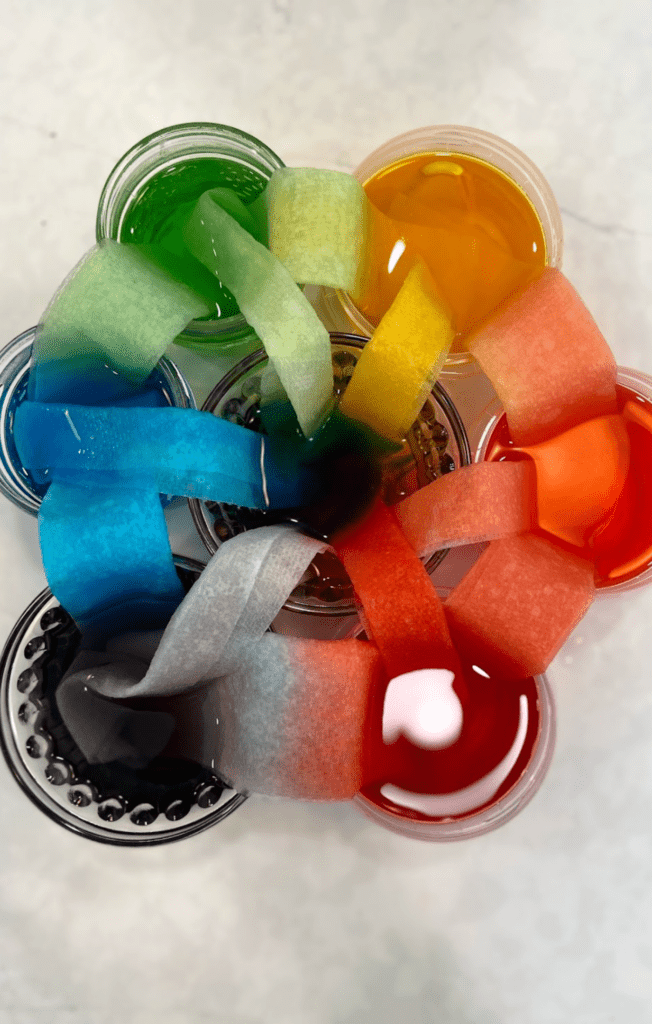
Why is the water moving so slowly?
If your rainbow water experiment is taking a long time, you can add more water to jars 1, 3, 5, and 7. Adding extra water will make it easier for the water to move up the towels! We sometimes add more color to keep the colors intense too otherwise they will get diluted.
Prompts for deeper learning
There’s a lot of cool stuff happening in this simple experiment! To deepen your child’s understanding, here are some discussion prompts:
- Talk about color theory. Do they know what red, blue, and yellow colors are? (Primary colors!)
- If we only used primary colors in the beginning, how did we end up with a rainbow in the empty jars? (Hint: the colors mix to make secondary colors!)
- Encourage hypothesizing.
- Ask questions like “What pulls the water upwards?” “Does water usually move like that?”
- And, see what happens if you use the paper towel as a ‘bridge’ – Does any water fall between the cups? Why or why not?
- Ask them to draw what they saw. Learning can be displayed in more ways than one. Talking about our hypothesis and writing them down is great, but some kiddos may be able to better express themselves through drawings!
- I once asked my Grade 2 class to draw what they saw during this experiment. One kiddo drew this super-cool roman battle-esque depiction where the water and food coloring molecules were fighting each other up the towel before tumbling into the empty jar. The towels were trojan horse-like characters. Hands down one of my favorite learning moments!
Conclusion
This fun hands-on walking water experiment is a great way to teach your child about the concept of capillary action. This is the ability of a liquid to flow against gravity in a narrow space, such as the paper towel in this experiment. When the water reaches the top of the paper towel, it’s because the molecules of water are attracted to the molecules of the paper towel. This causes them to stick together and creates a sort of “water bridge” that the rest of the liquid can travel across. Surface tension helps the water molecules stick to the paper towel, letting it travel from one jar to the next without even a few drops of color spilling! Cool, huh?!
This is one of my favorite science experiments for kids of all ages. Since all you need is an empty glass (well, 7 of them), water, yellow, red, and blue food coloring, and paper towels, it’s also pretty easy to do at home! It’s so fun to watch all the jars fill up with colored water, making a rainbow appear right before your eyes. Trust me, kids will love this easy walking water science experiment!
It’s also a great chance to teach them about primary and secondary colors as you ponder things like “how come the green or orange never mixed into the yellow cup?”
Have you explored the adhesive forces of walking water and capillary action? We would love to see your walking water experiment!
More science posts
Searching for more science experiments and science-related activities to do with your little ones? Check out this category to see all of our posts about science for kids!
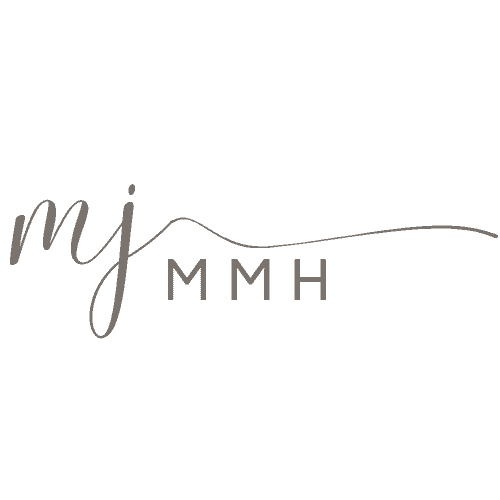
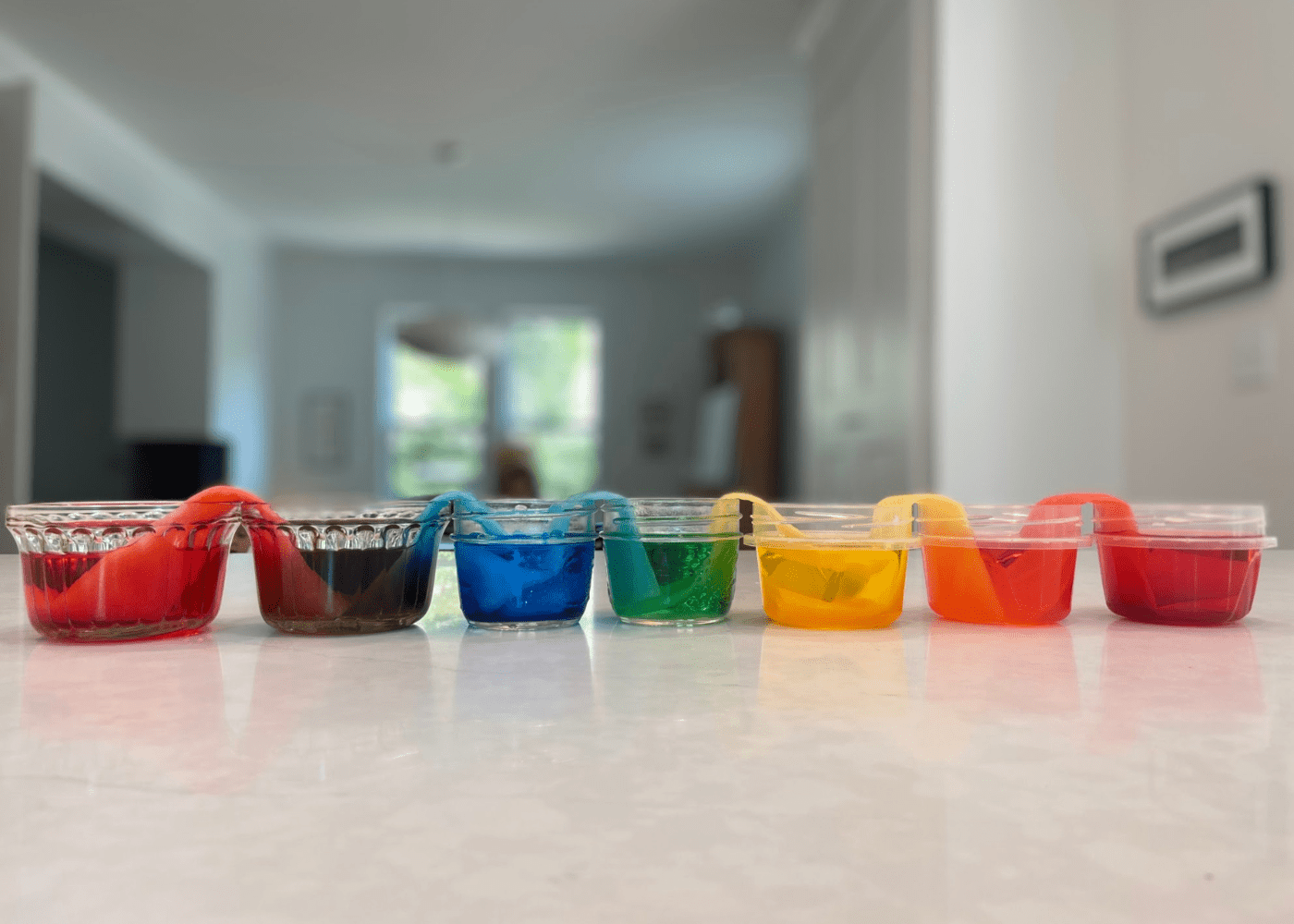
Leave a Reply